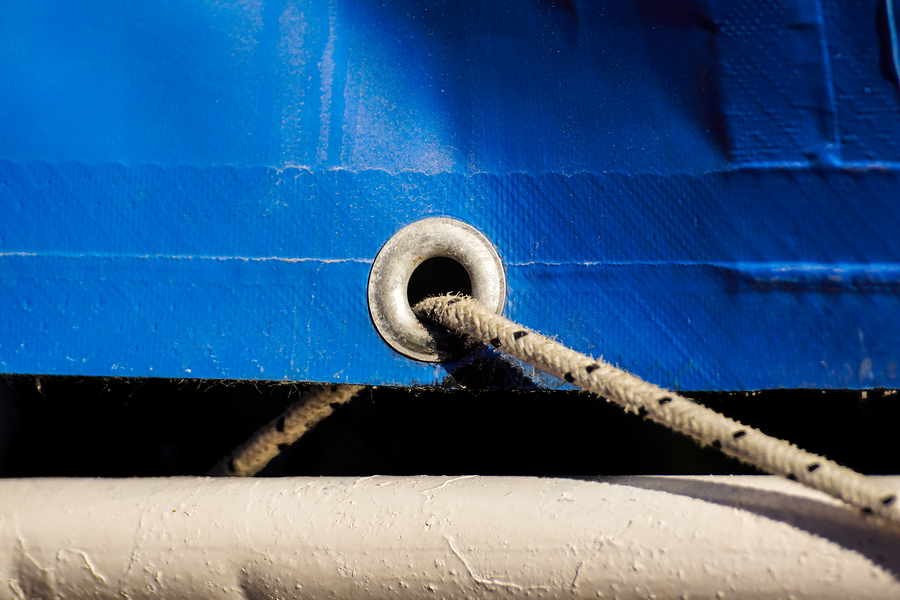Tarps. You probably know what they are, but how did they get their name? “Tarps” is short for tarpaulins. The name dates back centuries and has strong ties in the merchant marines and sailors of Britain. The sea can be a brutal place. Gales, crashing waves, and the work on ships/boats get the deck soaking wet. To stay dry, sailors and seafarers used sheets of canvas that they’d coat in tar to repel water.
These canvas sheets were used to protect supplies and equipment that needed to stay dry. They were also turned into hats and pants that sailors could wear to stay dry. While there is some debate, some believe that “tarpaulin” is a combination of “tar” (the sticky black coating) and “paulin” (a waterproof material used to make ponchos).
While tarps still help sailors, marines, and others keep their items at sea dry, they’re just as useful on land. People use them regularly to form protective awnings and tents at home, public events, and picnic/camping areas. Tarps are used to keep furnishings dry while being transported in a truck bed. They’re used to protect firewood from rain, snow, and ice. They are used at construction sites, archaeological sites, and so many other places. Tarps can cover a pool, protect a roof leak, or block wind on a deck or patio. You’ll also see tarps rolled out on ball fields during sudden showers or storms.
The Different Thicknesses of Tarps
Tarps come in a variety of thicknesses. The thicker the tarp, the more durable and heavy it is. If you have a tarp under 0.15 mm, it’s going to be a tarp designed for light-duty. It won’t last long in strong winds or heavy snow/ice. These are typically the blue budget tarps you find in discount stores.
Medium-duty tarps tend to be in the 0.16 to 0.25 mm range. These tarps withstand a little more than the light-duty tarps do, but they’re still not designed to take a beating. Stronger tarps are those in the 0.26 to 0.30 mm range (heavy-duty) or over 0.31 mm (super heavy-duty). Many retailers sell tarps by weights with 10 ounce being the lightest and 18+ ounce being heavy-duty tarps.
Material Is Another Important Factor
When you’re looking at a tarpaulin’s strength and durability, the material also impacts potential uses. Chicago Canvas & Supply sells a large variety of tarps in a variety of weights, fabrics, and colors. These are your options and how we recommend you use them.
Canvas Tarpaulin – Canvas tarps come in 10 oz, 16 oz, and 18 oz weights. Canvas tarps may be treated or untreated. Untreated tarps are not waterproof and are best used as curtains, dust covers, or floor/furniture protection when painting. Treated canvas tarps are not great for protecting things you do not want to be stained by the oils used to make the canvas water repellent, but they are good for protecting cargo, power tools and machinery, and farm equipment.
Clear PVC Tarps – Clear PVC tarps are 20 mm thick (18 ounce). You can see through them, which makes them handy for creating a curtain that doesn’t block light. We recommend them for wind protection on construction sites, to enclose a patio or deck, or to add a clear doorway or side wall on a large tent for parties or gatherings.
Drain Tarps – A drain tarp is a tarp that has a drain spout where you can drain away the rain. They come in a variety of materials depending on your needs. Reinforced polyethylene is not flame retardant, but vinyl laminated nylon is. The drains spout hooks up to a standard garden hose to direct rain away from the tarp roof that’s protecting your picnic area or worksite.
Iron Horse Polyester Tarps – These waterproof tarps are 15 ounce and are twice as strong as a canvas tarp. Plus, canvas tarps are water repellent, but Iron Horse tarps are waterproof. They’re a great choice for covering boats and outdoor furniture. They’re also the best choice for an outdoor canopy for a deck, porch, or patio.
Mesh Tarps – You’d use a mesh tarp for protection from the sun. The mesh does block some UV rays, but it doesn’t stop water or air from passing through. They’re a good choice for an outdoor shade tent. Plus, the mesh will keep away many biting insects. Vinyl-coated mesh tarps are good for privacy screens. Polyethylene mesh is great for screening off a deck or patio. Polypropylene offers the best protection from UV rays, which makes it a good choice for screening off a small pool or sandbox.
Polyethylene Tarps – Polyethylene tarps resist UV rays and water. Blue poly tarps are light-duty tarps. They’re often used to protect firewood from water, snow, and ice. You can also get brown, silver, and white heavy-duty poly tarps. They can protect the ground during landscaping projects, cover a roof that’s leaking, and protect equipment that’s being used outside.
Vinyl Tarps – Our vinyl tarps come in 13-ounce and 18-ounce options. The 13-ounce vinyl-laminated tarps are useful for welding curtains and room dividers. The 18-ounce vinyl-coated tarps resist tearing and repel rot. Use them to cover furniture and equipment on farms, industrial settings, and construction sites.
What do you need a tarp for? If you have an outdoor or indoor project that requires a tarp, let our experts know. We can help you find the right fabric, weight, and coating to ensure you have a tarp that meets your needs and is crafted to last. Reach Chicago Canvas & Supply online through live chat or by calling 1-866-389-2218.





